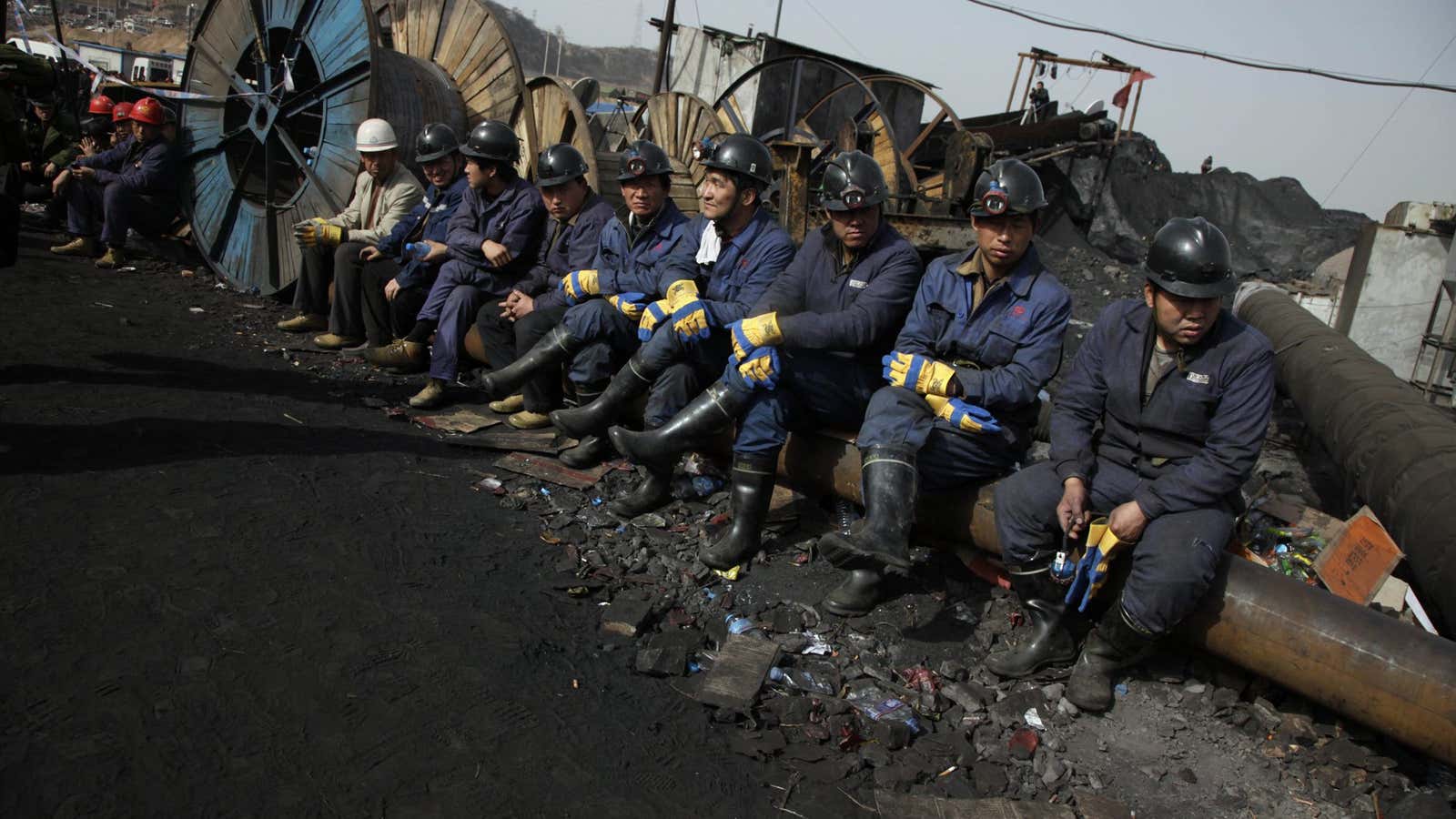Last week Donald Trump signed an executive order to roll back planned coal plant closures, following on from campaign promises to save miners’ jobs. “C’mon, fellas. You know what this is? You know what this says?” Mr. Trump said to the miners brought in to stand around him for a photo-op as he signed. “You’re going back to work.”
China, which accounts for about half the world’s coal demand and production, isn’t making similar difficult-to-keep promises. Instead, as it faces the prospect of finding new work for tens of thousands of redundant coal workers, it’s burying the tough truth in jargon. Instead of speaking of layoffs, China consistently describes the process its workers are going through “reallocation,” which suggests people won’t lose jobs, they’ll be sprinkled through the economy into new ones. And every time foreign journalists ask Chinese officials about lay-offs from its steel and coal sectors, a generally unavoidable corollary of cutting capacity, China responds by talking about how “reallocation” is going.
China’s leaders last year said they would “reallocate” 1.3 million coal workers (link in Chinese) and half a million steel workers, as the country tries to curb coal and steel overproduction, and also reduce pollution and emissions. The International Energy Agency has forecast the country’s coal demand to be essentially flat over the next couple of years as the country promotes a shift to renewable energy—the country’s investment in renewable energy crossed 100 billion dollars in 2015, according to the UN-affiliated renewable energy policy network REN21. Earlier this year, China canceled plans to build dozens of new coal plants (although it is at the same time encouraging coal plants elsewhere). Coal production in recent years has been on the decline.
But are they “reallocations” or layoffs? Is China being just as disingenuous as, some say, Trump is being, or can other jobs be found for all these workers?
Tim Wright, author of the The Political Economy of the Chinese Coal Industry and former professor of Chinese Studies at the University of Sheffield, noted that, ”coal mining areas tend to be rather specialized, and it is difficult to reallocate workers unless they move a long way from home.”
“There is little doubt that the vast majority of laid off workers ended much worse off,” says Wright, describing what happened when coal miners in Britain went through their decline, “I doubt things will be any easier now.”
Keegan Elmer, labor researcher with China Labor Bulletin (CLB), a Hong Kong-based watchdog, commended China for its focus on finding other work for miners—last year, Beijing said it was setting up a 100 billion yuan ($14.5 billion) fund to help coal and steel workers do that—but expressed doubt about how successful it would be.
“The government’s emphasis on finding new jobs for these workers is admirable, but very hard to actually achieve,” said Elmer, calling it ”extremely difficult for these workers to reenter the labor market at this stage in their life.”
Even before last year’s reallocations were announced, the country’s state-run coal mine operators had been suffering amid China’s economy slow-down, sometimes not paying coal workers for months. One state-run company, Longhua Harbin Coal Company (also known as Longmay), a subsidiary of China’s third-largest coal mining company, announced in 2015 it would cut 100,000 workers. That year, China saw an uptick in miner protests, often over unpaid wages and reduced hours.
Last year, in March, around the time of a major annual meeting of Communist Party, thousands protested against Longmay in the northeastern city Harbin over unpaid wages and salary cuts. In December, dozens of workers from Jiangxi Coal Group Corporation in China’s central province Jiangxi protest against their treatment after a mine shutdown. Weibo user Duan Xiaobai said (link in Chinese) the company only gave workers 700 yuan ($102) each the first month, and nothing after that.
“In many cases, workers are offered a more low-paying job, or low-paying internal retirement, a clear hit compared to their prior conditions.”says Elmer, of the labor nonprofit CLB. “That has in many cases boiled over into organized street protest.”
In 2016, the country saw the retrenchment of 726,000 coal and steel workers, according to Yin Weimin, China’s minister for human resources and social security, speaking at a press conference on March. 1 (link in Chinese). He also said that another half a million workers would be removed from coal and steel work in 2017. And so far, one third of the fund for workers has been spent, Yin said.
In a joint notice last month (link in Chinese), the Human Resources and Social Security department, National Development and Reform Commission and China’s finance ministry urged provincial and city government bodies to focus on job training and worker reassignment ahead the party’s 19th congress, a major leadership reshuffle event slated for this fall.
It urged companies to employ workers in other branches, or offer financial help to so people can start their own small businesses. Companies who find they don’t need a large number of workers should set up a dedicated recruiting section and recommend at least three alternate positions for workers within the company. Companies should also provide “one-on-one” advice in communities and mining sectors with a large quantity of people in need.
It’s difficult to know how these efforts are going so far. In some cases, miners are being reassigned to farm work on coal industry land. And yet, strikes by coal miners in China were down in 2016. It’s unclear, yet, whether that’s due to China’s increased spending on these workers or a more watchful police eye on workers who’ve been particularly active.
